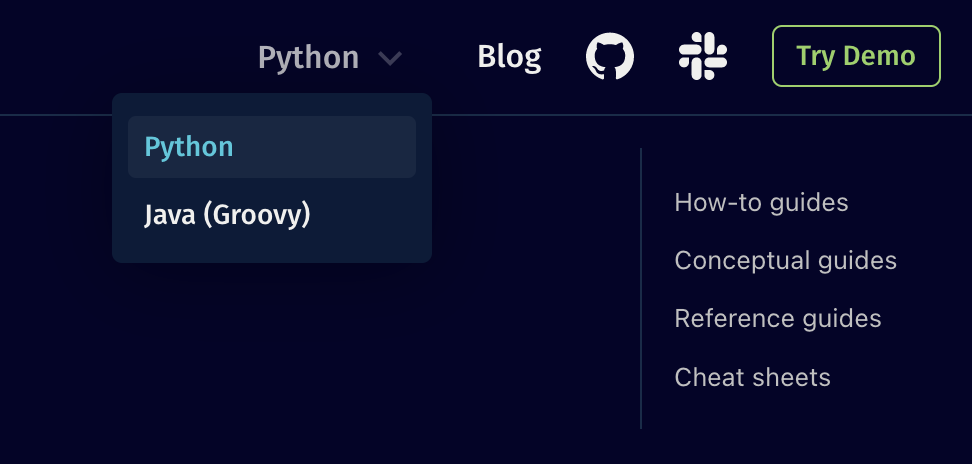Python versioned docs
In March, we announced our Python API v2 release candidate - better, cleaner, and more Pythonic. Now that the comment period has closed and v2 replaces our original API, we've completely revamped the user documentation to reflect the new syntax. The examples and code blocks in the documentation will be scripted in Python by default. You'll find a dropdown at the top of the site where you can switch the site to include Java / Groovy examples instead:

Other user guide additions
You'll also find documentation on several new features. In particular, learn how to install and use matplotlib and seaborn to take advantage of these data visualization tools with your Deephaven tables.
If you want to customize your Deephaven tables, check out our How to format colors guide, which shows how to color backgrounds, specific columns, create heat maps, etc.
The deephaven-csv repository will soon have comprehensive documentation and examples. In the meantime, the How to use the Deephaven CSV library gets users started with our high-performance CSV parser.
Blog updates
We're often asked how Deephaven compares to x, y, or z. One such comparison that comes up often is with Materialize, so we wanted to teach ourselves about their platform and provide a framework for community discussion. We thought it would e most effective to explore a use case of Materialize’s choosing, their e-commerce demo. To complement the example-app that provides the steps to recreate the demo and compare performance, our team wrote a series of blog posts that discuss our findings:
- Why deltas give Deephaven & Materialize their super-powers
- A performance comparison between two update models
- A design comparison between Deephaven & Materialize
- Updating data needs a stack, too
Chip Kent's post Quant-trading like Wall Street pros introduces our deephaven-IB integration. The deephaven-ib project allows you to combine the comprehensive infrastructure and low-cost trading of Interactive Brokers, the analytical capabilities and ease-of-use of Deephaven Community Core, and the ubiquity and power of Python to yield an open, real-time, quantitative trading platform.
Finally, Jake Mulford describes his journey to event-driven development in a post showcasing table listeners.
YouTube
This month we published a 10-part video series introducing and teaching how to use the Deephaven Learn library, our tool for real-time AI in Python. It has been engineered specifically to deliver Deephaven's "streaming table" capabilities - i.e., tables that magically update, append, or are otherwise dynamic - to Python data science seamlessly, intuitively, and with good performance.
Subscribe to our YouTube channel to view new videos weekly as we continue to post our weekly developer demos and learning sessions.

